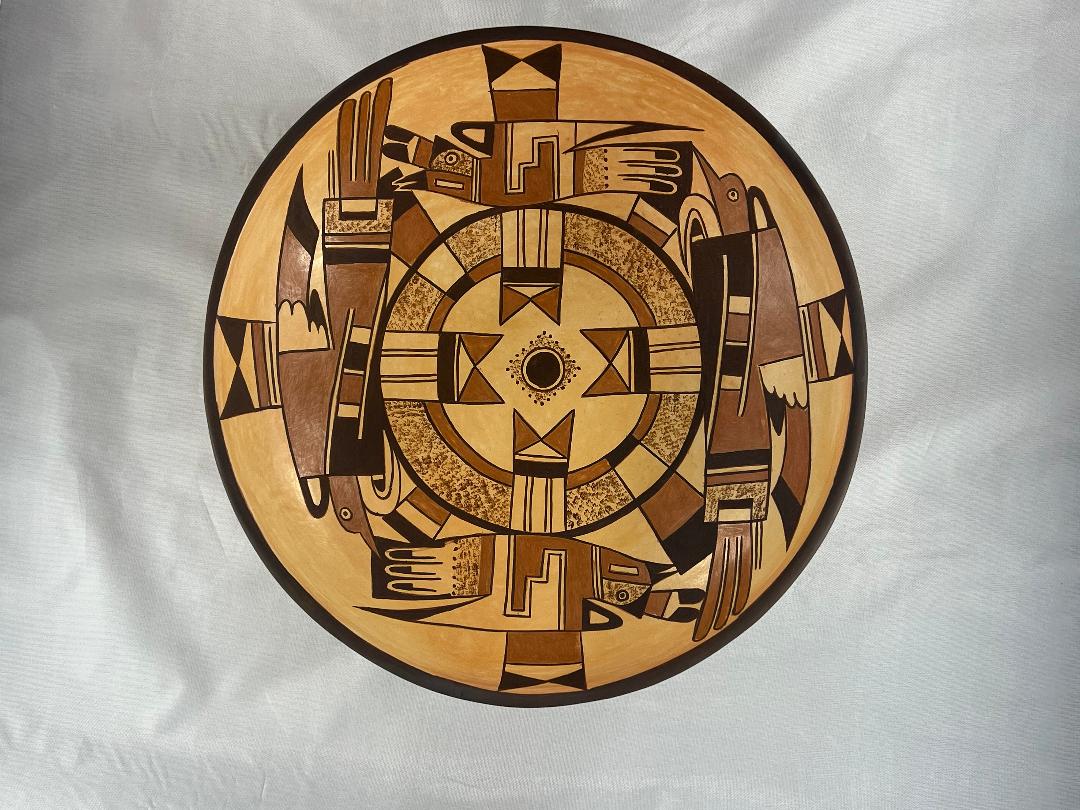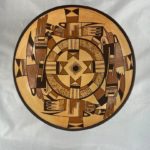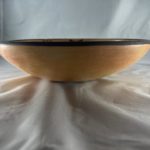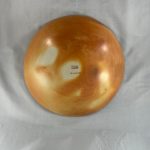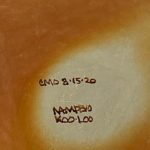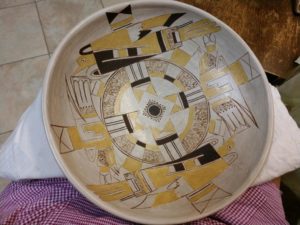This design is a kaleidoscope of motion and perhaps ritual: two pairs of birds fly in rotation over a central hub. One authority interprets this pattern as having spirtual meaning, but it may be just a design. Once we have examined the pattern closely, we will make our own assessment.
The decoration is derived from a Sikyatki canteen (ca 1400-1625 CE) that inspired Rachael to recreate the design on a bowl more than a dozen years ago. For a photograph of the ancient Sikyatki canteen, see Moulard (2002: Plate 88 facing page 147). Only small details distinguish Rachael’s design from that on the ancient canteen. I so loved the image of Rachael’s bowl that I saved it for more than a decade: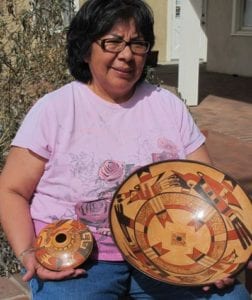 Rachael and I were in frequent contact during the pandemic summer of 2020 and at some point I commented on the photograph of Rachael with her earlier bowl. That led to her making me a bowl 2020-09 on commission. Aside from her own mark, she added my initials and the date of firing ” 8-15-20″ to the bottom of the bowl. Here are photographs of the bowl just before and just after firing:
Rachael and I were in frequent contact during the pandemic summer of 2020 and at some point I commented on the photograph of Rachael with her earlier bowl. That led to her making me a bowl 2020-09 on commission. Aside from her own mark, she added my initials and the date of firing ” 8-15-20″ to the bottom of the bowl. Here are photographs of the bowl just before and just after firing:
Form: The bowl is of simple form, curving evenly from a flat base to a plain rim. As would be expected of this master potter, the walls are even and substantial but not excessively thick for a pot of this size. The exterior shows great variations in color, “blushing” from the outdoor firing. This characteristic is unique to Hopi pottery and one I particularly enjoy since the fire markes each pot as unique.. The inside, more protected during the firing, has an almost uniform golden color.
Design:
The most common colors on Hopi and Hopi-Tewa pottery are black and red. On bowl 2020-09 we find the expected black, but the second color is “burnt siena,” a reddish-brown. In the discussion that follows, I will simply refer to it as “siena.” All elements of design are outlined with a thin black line. The rim of the bowl is also painted black.
Perhaps uniquely, the design on bowl 2020-09 is layered in complex ways that need to be excavated layer by layer, as an archeologist might uncovering an artifact. Most obviously, notice that as the birds rotate around the central hub, they obscure portions of that hub; the birds are above the circular design. Our discussion will first highlight the underlying design and then the birds above it.
The circular hub and radiant ribbons:
The design rotates on an axis consisting of a central large black dot encircled at a distance by a thin black line. Set around it is a square, 7 dots on a side, the space between the box and the central circle being filled by stippled paint. A bit over 1.5 inches from this box three concentric bands begin a circular pattern. A medium-width siena band forms the inner-most circle, followed by a wide stippled band, then a thin black band, the outer circle.
These concentric circles are crossed by three pairs of ribbons: two large ribbons occupy the 12 and 6 o’clock position on a clock face, two slightly different large ribbons occupy the 9 and 3 o’clock positions, and two smaller ribbons emerge from the 1 and 7 o’clock positions. The two sets of larger ribbons overlay the circular pattern with the remaining smaller pair emerging from the edge of the design, a suggestion that this pair is positioned below the circular design and is thus obscured by it. All six ribbons have the form of a truncated wedge: their base is slightly narrower than their tip.
The smallest ribbons –at the 1 and 7 o’clock positions–are very simple. Their surface is divided into three roughly equal horizontal bands colored siena, unpainted and black as you move from base to tip. Note that the top band on the ribbon at the 1 o’clock position is subsumed into the black element around the tail of the bird above it. Since these two ribbons do not obscure the central circular motif, the artist may have simply presented them as attached to the outer circular edge. However, given that the other four ribbons extend toward the center of the design, I think the positioning of these smallest ribbons indicates that they under ly the central circles and are thus, visually, the lowest layer of design. The original Sikyatki canteen which served as the model for this design shows only one ribbon in this position. Rachael has doubled their number.
The larger ribbons at the 12 and 6 o’clock positions are clearly painted above the concentric circular design and thus obscure it. However the outer ring of birds obscures a portion of the ribbons and thus the birds are visually the top layer of design. Said somewhat differently, this pair of larger ribbons is sandwiched between the birds above and the concentric circles below. Both ends of the ribbon are formed by a pair of painted triangles with their tips touching, this leaving an unpainted triangle trapped between them and the rest of the ribbon and an unbounded unpainted triangle on their outer edge. The triangles that form the central end of the ribboin are siena. Above them a thin black line separates the tails from a thin unpainted space above. Next is a thick black band surmounted by an unpainted space that extends to the outer bans of the circular motif. Set into this unpainted area are two sets of parallel black lines (“one-lane highways”) that divide the space into three equal portions. Emerging from under the birds towards the outer edge of the bowl, these ribbons display a solid siena rectangle surmounted by the same touching-triangle pattern we saw on the other end of the ribbon, the only difference being that this end of the ribbon is formed by black triangles.
The two ribbons that cross the design at the 9 and 3 o’clock positions are quite similar to the first pair of large ribbons, but differ in detail. The section between the center of the bowl and the black outer concentric ring are formatted exactly the same as the first pair of large ribbons. Emerging from under the birds, however, there is small difference. Instead of a large siena rectangle, on this second pair we see a small, unpainted rectangular space with a moderately thick black line suspended in its center. Above is a similarly-size rectangle painted siena. The ends of these ribbons (two black triangles touching) are exactly thae same as on the first pair of large ribbons.
Larger birds:
The larger birds might be red shaft woodpeckers. Their design is complex: irregularly-shaped pieces that resist description, yet fit together to form a coherent pattern. The head is sold siena with a circular eye with a black-dot pupil. Flanking the head are two U-shaped elements, their curved edge forward. The top U is a simple thick black line with an unpainted center. The bottom U is tapered off of a thicker base and is simply outlined. The head borders an irregular bifurcated solid-black form that slopes downward, the abstracted body of the bird. The lower half of this element forms a triangular blade; the shorter upper half is a truncated rectangle. Growing from this rectangle is a linear section of rectangles: 1) a medium size unpainted rectangle is followed by 2) a large siena rectangle a then 3) thin-unpainted, 4) large-black and 5) medium-unpainted rectangles.
Set above this design is an irregular siena form, the largest element in the bird’s body. The shape is an abstracted wing, though one whose lower section merges into the bird’s body.. The left half of this form is a truncated cone with non-parallel sides. Its lower right corner provides a narrow passage for the siena color to expand into a wide roughly U-shaped shape with its right side pointed as expands from the narrow passage and its left side flattened as it meets the linear section of rectangles. Set against the rear base of this large siena element are 1) a thick black stripe, 2) a thin unpainted stripe and 3) a medium-thick siena stripe. These stripes are followed by a thick C-shaped form with square corners, its interior stippled. The inner edge of this C is lined with black, wider on the long edge and thinner on the two flanking edges. From the rear-facing mouth of the C spring three round-tipped siena tail feathers that emerge from a common base. From the top edge of the stippled C two thin parallel lines flow backwards.
Look at the rear edge of the upper portion of the large siena element. It forms the base of an unpainted form in the shape of two pairs of rounded hills. Set against the upper and larger pair of hills is a knife-shaped blade, its top edge longer than its bottom edge. Interior to the blade is another smaller siena blade. A wide black strip fills up the remainder of this element, thus forming its tip. Set over the lower and smaller pair of hills is a single, large black hill. The bases of both pairs of hills have thin, pointed bases since they conform to the shape of the hills from which they grow.
Overall the two large birds present themselves like crazy quilts that have clear exterior form but whose interiors are patchworks of irregular shapes.
Smaller birds:
The smaller pair of birds might be shrikes, their bodies patchworks of design. This pattern is somewhat more constrained than the interior of the larger birds. The heads of these birds are composed of four elements. A triangular solid black crest surmounts a stippled area with a curved upper edge and a linear bottom edge. In the middle of the stippling is a black circular eye with a black pupil, the same form of eyes that we saw on the first pair of birds. Below is an almost rectangular space, its lower edge slightly curved because it is also the lower edge of the bird form. This rectangle is colored siena except that at its center is an unpainted rectangle. The front edge of the rectangle is the base for the bird’s black beak, two isosceles triangles growing from a common base.
Behind the head is a thick crook shape painted siena, open end upward with its left arm notched once on the exterior and its left arm notched twice on the interior and this forming a two-step edge. Such stepped forms are thought to represent rain clouds and this are a blessiong (Patterson, 1996:xx) and are frequently found on ancient pottery (cf xxx-yy). The space around this siena crook is unpainted and this forms a reciprocal crook conforming to the siena crook below it. An observer’s eye sees this as either 1) an unpainted section of design with a siena crook inserted or 2) a siena colored space with a residual unpainted crook. Such “figure/background reversal” is typical of pottery produced at Hopi, energizes the design, and was frequently used by Nampeyo. (See Appendix F.)
From the rear edge of the unpainted crook there are two design patterns. The top is a large, black, right triangle enclosing a smaller unpainted right triangle, another example of figure/background reversal. If the black portion is seen as residual, it forms a thin “V” shape with a flat upper edge and a sloped lower edge. The lower pattern begins with three different linear elements: a stripe of siena, a wider stippled section, followed by a row of 5 or 7 dots. (The number of dots varies between the two renditions of this bird.) Growing from an unpainted base are three feathers with unpainted shafts and rounded black tips, the tips caping a thin black stem. These three tail feathers are then enclosed by a black form, the sides of the form are thin, the end is thick with a flat outer edge, and the interior edge conforms to the rounded edges of the feathers. In one rendition this final black element is distinct from the black-tipped ribbon below it. In the other rendition the two black elements merge into a single form.
This completes the description of the pair of smaller birds, except for one seeingly misplace element. Growing out of the upper face of the smaller pair of birds is a tail consisting of a rectangular siena base supporting two feathers with large, black rounded tips connected to their siena bases with thin, short black stems. These feathers are thus a variation of the three black tail feathers. On the ancient canteen only one of this pair of smaller birds has tail feathers growing from its head. On bowl 2020-09 Rachael has included this element on both birds. This is anatomically incorrect and may have been drawn by the potter of the ancient canteen as a whim or may have some meaning that is unknown, at least to me.
Meaning?
Both Hopi artists like Fred Kabotie (1982) and Anglo ethnographers like Alexander Steven (who during the last decade of the 19th century lived on First Mesa) have argued for direct links between ancient and modern Hopi beliefs (Patterson, 1994). Barbara Moulard takes a similar stand:
“That the Hopi can so readily translate the iconography of…exquisitely painted ceramics after a two hundred to five hundred lapse in time speaks volumes about the conservative nature of Hopi social and religious traditions (2002:168).”
Moulard offers interpretive commentary on the ceramics in her book, but I am not sure if Native people, Anglo scholars, or her own experience was the source for her interpretation. Moulard’s comments about the ancient Sikyatki canteen begin with a quote from ethnologist Alexander Stephen. His entry for Tuesday, December 22, 1891 reads in part:
“The standard na’chi on all kivas is the same. Muri-nayauwuh, red shaft woodpecker (Parsons, 1936:7).”
Moulard then comments about the design on the ancient Sikyatki canteen that served as the model for bowl 2020-09:
“A pair of opposing red shaft woodpecker alternate with pair of smaller birds, making a ring around a red splatter-filled circle painted on the dome of this large canteen. The painting is unbounded at its outer edge, and the attachment of avian figures to the thick band is similar in concept to ‘sky band’ imagery found in many Jeddito Yellow Ware bowls. As suggested in the quote from Stephen’s Hopi Journal, the woodpeckers are associated with the Hopi Soya’la, or winter solstice ceremony, and particularly with symbolism used by the War Society during this season. The smaller birds represented here may be shrikes (there is a strong resemblance through the beak) or possibly swifts. Both of these fast-flying birds are found in emergence mythologies helping the people trapped in the Underworld by locating the si’papu or opening. The strike, known to impale small pray on thorns, is also identified with the death god Masu’wu, whom the people first encountered after emergence. The symetrical, circular imagery of the canteen is…synonymous with the si’papu entrance to the spirit through which humans entered this Fourth World…The complex imagery suggests that (the ancient design) was likely of ceremonial importance (Moulard, 2002:169).”
According to one version of the Hopi creation myth, a tiny shrike found an opening at the top of the underworld, and the chipmunk made a plant grow up to it so that the First People could climb out. Perhaps the perspective of 2009-09 and of the ancient canteen on which its design is based is from the Third World looking up at the si’papu high above through which the strike will help virtuous people enter the Fourth World.
Ed Wade suggests a ritual function for the ancient canteen on which 2009-09 is based. Concerning canteen 2009-10, Ed wrote:
“There exist a few elaborately painted canteens from the Sikyatki period (A.D. 1375 – 1625) and later. However, many of them exhibit minimum wear, suggesting that their role was more ceremonial than functional.”
Since the Sikyatki canteen published by Moulard and used as a model by Rachael for plate 2020-09 does not show ware, it and its design may well have had ceremonial function.
This collection contains a canteen by Mark Tahbo with a much simpler design than bowl 2020-09, but the story represented by both designs seems essentially similar and is in line with the explanation that Moulard offers. Rachael and Mark were friends, but she tells me (11-2-1-20) that she does not remember showing the Moulard book to Mark or discussing this design with him. Mark may well have owned his own copy of the book. If so, Mark may also have been inspired by the same ancient Sikyatki canteen that suggested this design to Rachael Sahmie. For additional details, see the catalog entry for Mark’s canteen, 2018-01. If both Mark and Rachael were inspired by the design on the same ancient Sikyatki canteen, it would explain why these two modern pots are the only examples I know of that display designs with depth on a flat surface.
In that same telephone conversation Rachael said that she was not aware of the depth shown in the original ancient design and did not think about the design meaning. “I just get into the flow of working the paint and do not really think about the meaning,” she told me. Her sensibility has a long heritage. Almost 100 years ago Ruth Bunzel pointed out a pattern of design to a Hopi potter. “Yes, that is right,” replied the potter, “We always do it that way, but I never thought about it before,” to which Bunzel comments “She (the potter) has experienced (the design) unanalytically as a configuration….(Potters) have a perceptual rather than an intellectual approach to the aesthetic problem…(S)ensation and intuition play a larger role than intellect in the creation of design (1929:53).” I suspect this is true of most great artists: they create what pleases them and generations of academics scurry after them trying to explain meaning.
Given my academic background, I will now engaged in such scurrying. The central dot at the center of the design might well be the si’papu, the portal of emergence of humans up into this Fourth World and the entry point for the souls of the dead as they travel down to the Underworld. The original si’papu is in the Grand Canyon and is bracketed by eddies, perhaps here the concentric rings around the center of the design or these rings might indicate the travel of humans away from the place of emergence.. For hundreds of years a representation of this si’papu has been a feature in the many religious kivas at Hopi. This unassuming hole is central to Hopi understanding of their place in Creation.
The four large ribbons and two smaller ribbons are also suggestive. Upon their emergence into this Fourth World through the si’papu, the various Hopi clans migrated in all directions before eventually settling on the three Hopi mesas in Arizona. The Hopi acknowledge six directions: 1) up, 2) down, plus the points on the horizon that mark 3) the winter solstice, 4)the vernal equinox, 5) the summer solstice and 6) the autumnal equinox, these last four represented by northwest, southwest, southeast and northeast (Wade and Cooke, 2012:27-28). I believe the two short ribbons represent Hopi emergence up into this world and the departure of the spirits of the dead down to the underworld through the si’papu, while the four large ribbons represent the four cardinal points of the Hopi migration before settling at Hopi.
If you are impressed by this suggestion you should pause and recognize that such meaning is only speculation on my part. The design simply fits what, as an outsider, I know about Hopi beliefs. Obviously we cannot know what meaning the potter of the ancient Sikyatki design intended, if any, nor do we know how a modern Hopi spiritual leader might see the design on the ancient Sikyatki canteen or on bowl 2020-09.
Before Moulard’s statement that red shaft woodpeckers and shrikes play specific roles in the emergence from and return to the underworld, I was unaware of the role that these specific birds might play, but certainly birds and feathers of birds are central to Hopi religious beliefs. Feathers, particularly in the form of “pahos” prayer sticks, carry Hopi prayers to the gods and feathers are the most common design element on both ancient and modern Hopi pottery. I am aware that the feathers of different birds are used for different purposes in pahos and that for Native People feathers fringe the portals to other spiritual realms. (See the discussion of bowl 2013-16.) Also see Appendix F: Nampeyo’s Design Elements for the variety of feather designs she used and “Folk Art Birds” in the “Category List” for avian images on Hopi pottery. Thus it is not surprising to find that bird images are central to the design on both ancient and modern Hopi pottery.
Having finished the assessment of bowl 2020-09, we return to the question we initially asked: Does the design on this bowl spiritual meaning? My conclusions are both analytic and speculative, but I think five bits of evidence we have discussed support the conclusion that this is a spiritual image 1) Following Ed Wade’s suggestion I think that the lack of ware on the ancient Sikyatki canteen indicates that it was produced for ceremonial and not utilitarian purpose. 2) Except for the ancient canteen shown in Moulard and the pots by Mark and Rachael derived from it, I know of no Hopi pottery with a design that is layered to show depth. Something unusual is going on here. 3) The si’papu is a central image of religious meaning for Hopi, represented here by the central black dot. 4) As noted, the two short ribbons might indicate the directions of emergence and return through the si’papu. Emerging into this world, humans migrated in all directions, hence the four longer cardinal point ribbons. 5) Birds and feathers carry Hopi prayers to the gods and, while both birds and their feathers are common designs on Hopi pottery, their prominent appearance on this bowl is still a form of prayer. Cumulatively these four indicators form a pattern indicating that the design on bowl 2020-09 may well have religious significance.
What is unarguable is the astonishing brilliance and energy of the design. My eye is pleasured by its color, form and motion just as it was when I first saw this design on the bowl pictured with Rachael at the beginning of this catalog entry. Above all, bowl 2020-09 is a dazzling, beautiful object.

